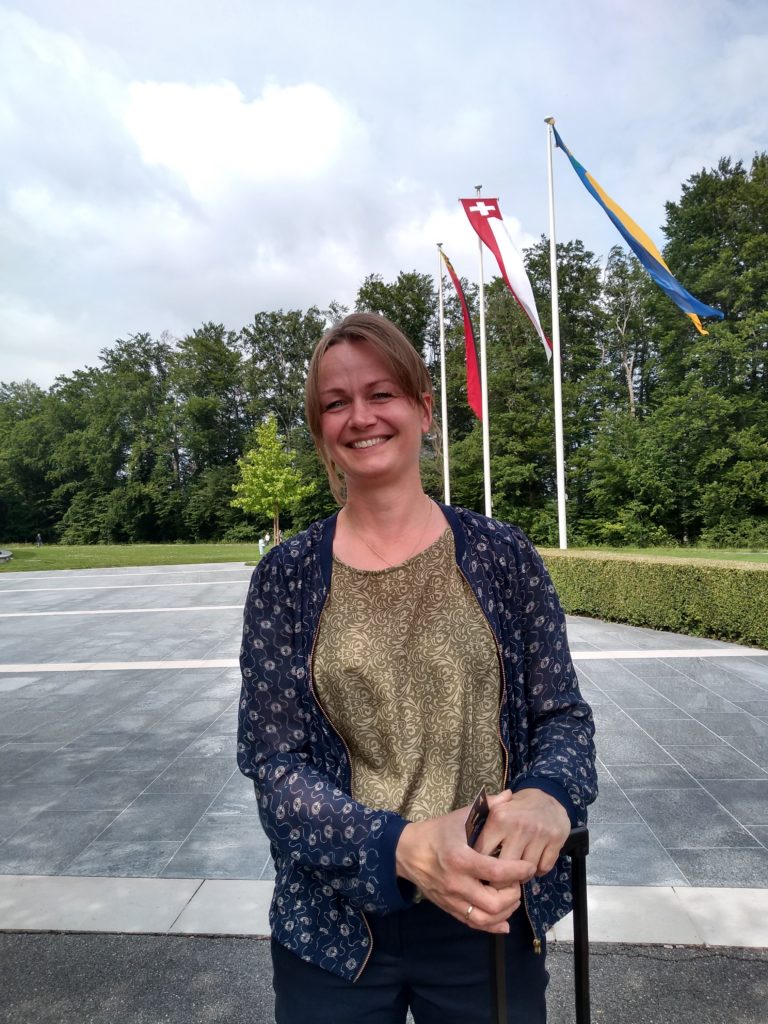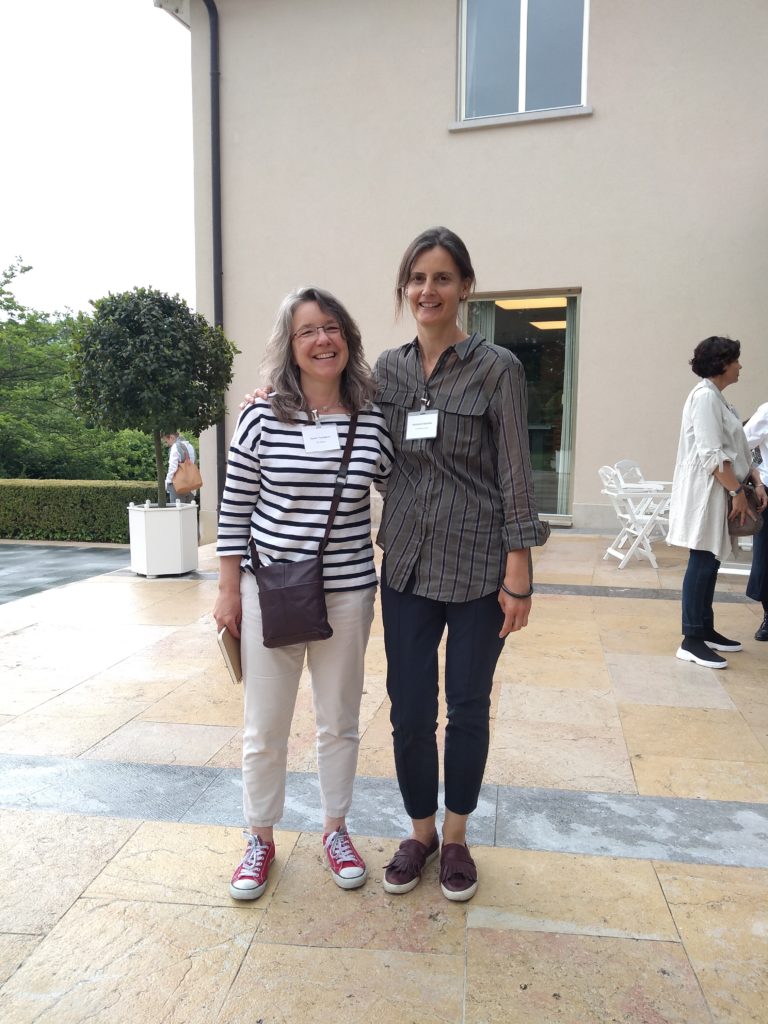
by Karen Thompson, Lecturer, MPhil Textile Conservation.
Having just unpacking packing my bags from a trip to Belfast for Icon19, it was time to set off again this time to Switzerland to attend the ICOM-CC Textiles Working Group Interim Meeting 2019. The conference took place over two days on the 20th and 21st June 2019 and provided all participants with an excellent chance to indulge in textile discussions. The conference, entitled: A Challenging Dimension: The Conservation and Research of Costume and Accessories, was held high on the hills in Riggisberg, near Bern in Switzerland at the world renowned Abegg Stiftung. The Abegg Stiftung is a leading collection of textiles and applied art and an internationally acclaimed textile conservation studio and education centre for conservators.

Delegates arriving for the day’s session
Inclusion and ethical considerations:
The power of public engagement was illustrated in an entertaining talk by Paige Myers and Kendra Floyd (A bow to society: When a social group transforms an exhibit). They described an exhibition at the North Caroline Museum of History about the African American seamstress, Willie Otey Kay who designed and made gowns for brides and debutants and who was in high demand from all sectors of society. The exhibition developed from a modest exhibition of some of Kay’s gowns to a rolling exhibition and catwalk show as members of the public demanded their dresses to be included. The talk showed the power of word of mouth to create a buzz around an exhibition which was fuelled by the visitors’ competitive nature as they didn’t want to be the ones who missed out on showing their gowns. The exhibition team and conservators found creative solutions to meet the community response and make a case for conservation too.
A talk by Dana Goodin and Kelly Reddy-Best, Queer Bodies: A case study of mounting and conservation ethics in practice exhibiting queer and non-binary dress and fashion raised important questions about what museums are collecting and how what we collect now will inform our view of the past. The exhibition explored the role of gender in fashion informed by queer critical theory, conservation and ethics. In response to the question of collecting policies and how to represent a wider cross-section of society, the museum put out a call for garments from the LBGTQIA community. Clothing in current use was loaned by the public for the exhibition and the donor’s stories formed part of the display. As with the Willie Kay exhibition, display of garments that are still owned and some still worn by the public presented interesting challenges in terms of display and representation.
Glamour meet conservation
Teresa Cristini Toledo de Paula and Larissa Torres Graçia presented an entertaining talk (Bananas ‘is’ Conservation Business: Carmen Miranda’s costume conservation project: curatorial challenges in an international approach) on the hats of Carmen Miranda for the new exhibition at Museum of Image and Sound in Rio de Janeiro that has been developed to display artefacts belonging to Carmen Miranda. The conservation work was done in collaboration with conservator Alison Lister (Textile Conservation Ltd) as the museum wanted to an unbiased and international approach. Marina Herriges, a Brazilian student who is currently a student on the MPhil Textile Conservation Programme, was also involved in the conservation work. Working with objects that had been worn and displayed for many years, repaired, and comprised of many different materials presented many conservation challenges and the role of facsimiles where the original was too in too poor condition display were discussed. Their talk was framed in the wider context of the international influence and importance of Carmen Miranda for Brazil as a cultural and fashion icon. Her international influence even found its way to Bern, apparently there was graffiti depiction of Carmen Miranda at Laufen Platz in Bern!
Constantze Zimmer, a conservator working for Textile Conservation Limited provided insight into other iconic costumes through her work with the Alternative Miss World costumes which were worn by the artist Andrew Logan. The costumes represent Logan as half male and half female with many of the female halves designed by Zandra Rhodes and many are on display in the Andrew Logan Museum of Sculpture in Wales. Zimmer discussed collaborating with the museum and artist, practical and ethical issues conserving items that were not originally created for the long term, the challenges of conserving the costume which are made from a wide range of materials as well as the decisions that involve the authenticity of stains and damage. The work was a great illustration of the diversity of objects we as conservators have the chance to work with and how we can find creative solutions to conservation challenges.
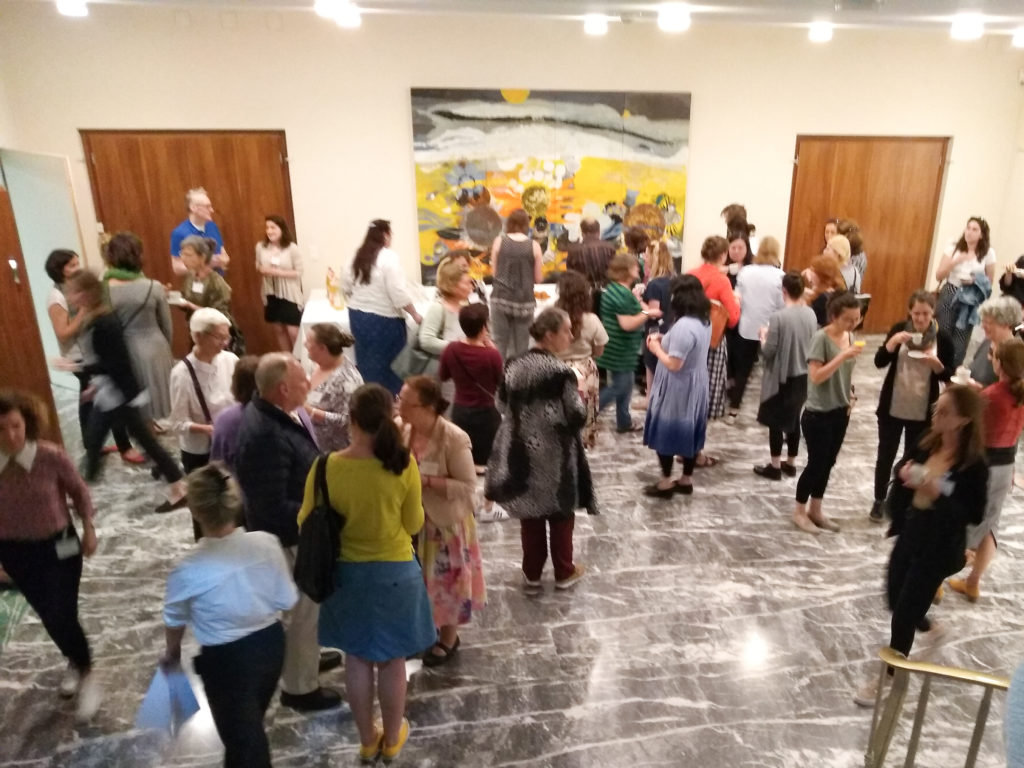
Innovations in Conservation
Deborah Panaget in her talk Study and conservation of an evening beaded dress from the “années folles”: Costume mounting by a virtual modelling in 3D and research of a material adapted for the weight issues of the dress described the conservation of a beaded dress by Chanel. To inform the display of the beaded dress, Panaget worked with textile engineers to carry out 3d modelling with diffferent types of support fabrics using the online database ‘Kawabata Evaluation System for Fabric’. They were able to recreate the textile properties, show stress and strain on the dress and how this is changing the different fabric and padding on the mannequin altered the stress and strain and informed the approach to mounting. As a result of this research, the decision was made to cover the mannequin using microfibre fabrics in specfic areas to provide the best support whilst the dress is on display.
Where science and conservation meet
A number of talks presented overviews of current research being carried out. This included research into conserving weighted silks presented by Rosie Chamberlain (former CTC graduate) and Lucia Pereria Pardo, In Search of Solutions: The Conservation of Degraded Weighted Silk Costume 1837-1910), the conservation of beetle wings on costume presented by Lauren Osmond Exploring Suction as a method for the Reversal of Unwanted Structural colour Change of Beetle Elytra on Textiles, and the analytical study of the silk textiles including material characterisation and determining the most suitable conditions to prolong the collection’s lifetime in the museum on excavated costume fragments recovered from a shipwreck by Anna Serrano, Agnés Brokerhof, Bart Ankersmit, Maaren van Bommel Mateiral Investigation of a Unique Archaeological Finding of Silk Fragments and its long-term preservation. The talks reflected the diversity of our work as conservators and once again highlighted how science underpins our work and helps us to move forward. I look forward to learning more about these research projects as they develop. If you are interested in contributing to Rosie and Pardo’s research and have experience of working with weighted silks do contact them.
Role of replicas in conservation and the ethics of display
The role of replicas in informing understanding, conservation and display and what and how to display objects were discussed in a number of talks. In their talk A dress fit for a king?, Melangell Penrhys, textile conservator, and Michelle Barker, historical reconstruction specialist, shared their experience of collaborating to reconstruct an eighteenth century silk gown for display in the National Trust’s Berrington Hall.This involved the reconstruction of a dress from pattern pieces from a deconstructed silk mantua and the creation of a replica sleeve and stomacher to complete the dress. The process of which was filmed generated wider public engagement. Michelle Barker is developing a glossary on is developing a database on patterns and stitching and has some useful resources on her website on eighteenth century clothing.
Zenzie Tinker and Rachel Rhodes – Hidden Treasures, Altered perspectives: The challenges of re-conserving the royal funeral effigies from Westminster Abbey discussed aspects of the three year project which involved over 300 effigy items. As part of the project they established a timeline for all the changes and alterations to each effigy to inform their conservation plan. In the talk they focused on the challenges in re-treating the effigies as well as the mounting and display in the round of these unusual objects. The effigies had previously been only viewed from the front as the backs were incomplete so as part of this conservation work replica fabrics were used to infill missing areas to create the splendour and impression of these regal robes.
Beatrix Nutz, Rachel Case and Marion McNealy in their talk Reconstructing medieval garments – Pitfalls and Successes discussed an almost unique collection of 2700 fragments which were found under the floorboards of a fifteenth century castle in East Tyrol. Through the study of the fragments and medieval images, reconstruction garments were made. This even involved spinning new linen thread to create the correct twist and ply. In one example, they showed how they recreated a headdress made with sprang insert which was originally thought to be a bra showing the value of reconstructions to inform understanding.
The conference also had a ‘Pecha Kucha’ (Japanese for ‘chit chat’!) session, chaired by Mika Takami. This involved four short 5 minute talks which provided the essence of a project or research. These were challenging to chair to keep in the tight time provided as the talks’ generated lots of interested questions. This was a great format and an excellent way to disseminate some of the work we do.
Questions generated by the day’s talks were explored by the panel chaired by Suzan Meijer (Head of Textile Conservation at the Rijksmuseum) and included Bettina Neikamp ( Head of Textile Conservation, Abegg Stiftung), Dr Dinah Eastop (Honorary Senior Lecturers, Institute of Archaeology, UCL), Dr Mary Brookes (Assistant Professor, Durham University) and Sarah Scatturo (Head of Conservation, Metropolitan Museum of Art).
We had the opportunity to tour the conservation labs which provided the chance to see the conservation challenges and breadth of the conservation projects currently being worked on at the Abegg Stiftung. This included the stabilisation of beaded purses made of minute seed beads using conservation grade adhesives and ‘silk flour’, cleaning and support of grave clothing and localised rust stain removal on a 16th century costume. We were also lucky enough to be able to see the spectacular yellow suit comprising a 16th century jerkin and doublet worn by the elector August of Saxony which was discussed in the talk by Lara Deck, Bettina Neikamp and Agnieszka Wos-Jucker. On a walk with the elector August of Saxony. What do we know about the original appearance of his yellow and black costume?
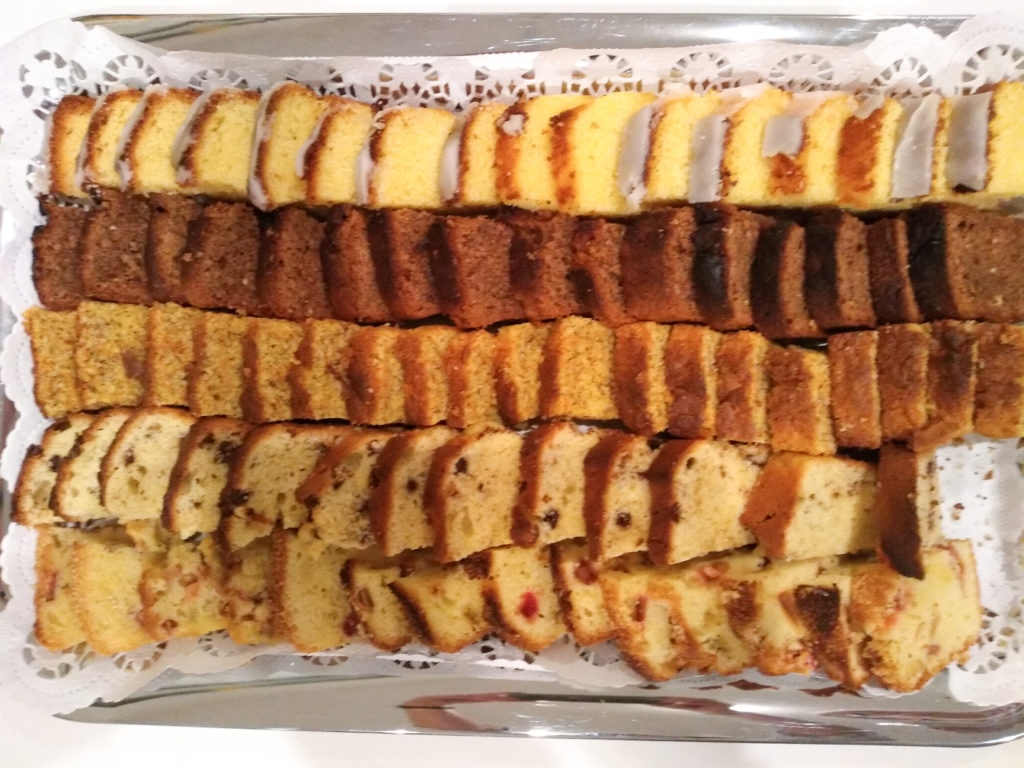
Time for tea! 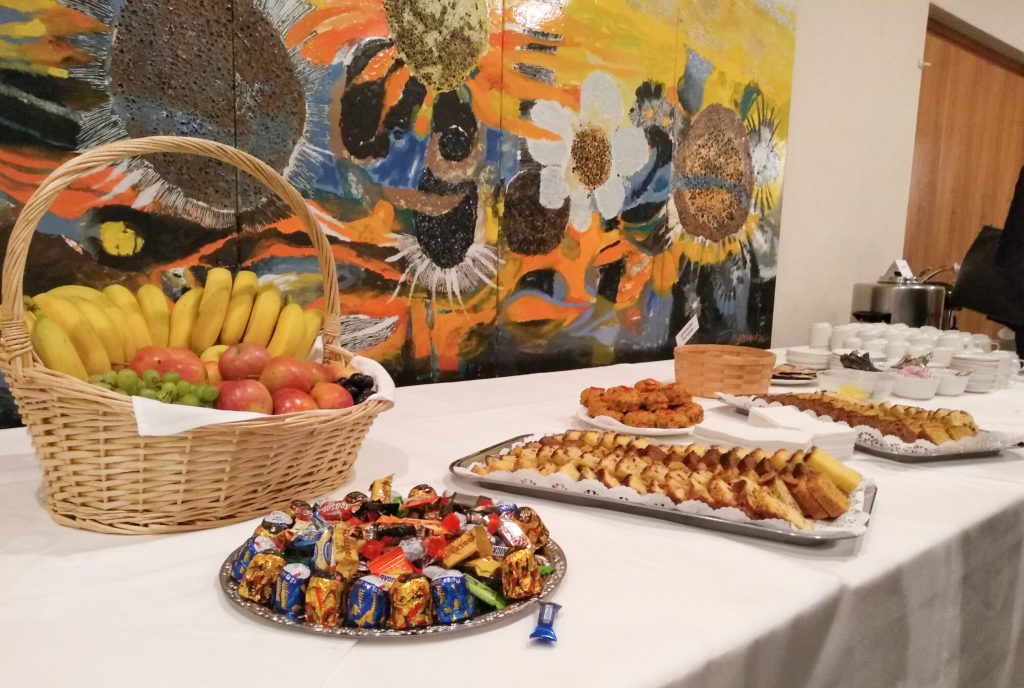
The hospitality of the Abegg Stiftung was outstanding. They created a welcoming and relaxed atmosphere that provided a great opportunity to meet up with new and established colleagues. It was great to be able to talk to colleagues working all over the world and consider our work as textile conservators in this context. I was also delighted to have the opportunity to meet some of our placement hosts who generously support the development of new textile conservators as the hone their skills.
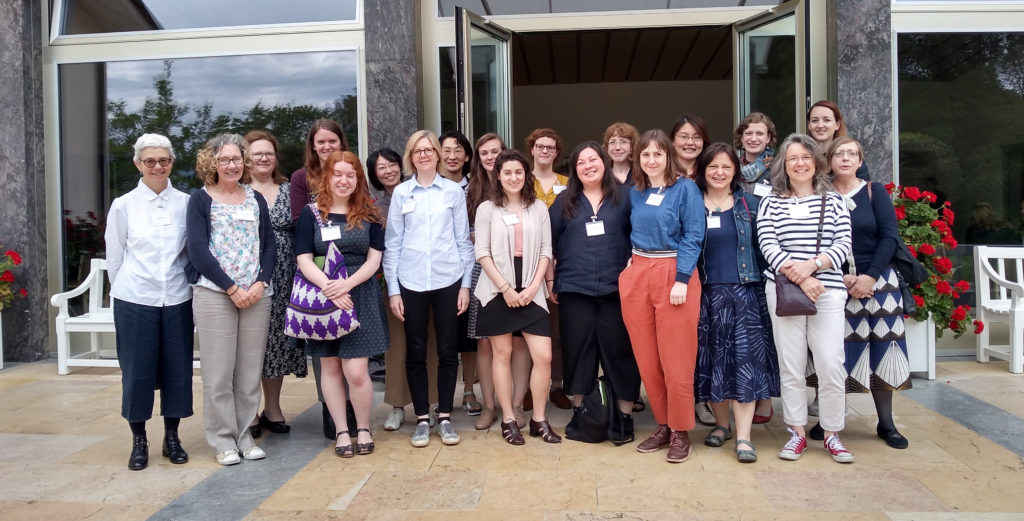
It was lovely to gather together so many TCC and CTC staff, graduates, interns and students
The staff of the Abegg Stiftung Conservation Department hosted a fabulous conference dinner held at a historic restaurant on the outskirts of Bern. Following drinks in the garden, we enjoyed a delicious four course meal and excellent company. The buzz from the delegates was palpable and reflected the positive atmosphere of the conference. Special thanks to the conservation staff – Regula, Bettina and Caroline. We also had the opportunity to thank the chefs, cooks and waiting staff who were invited into the conference hall so we could offer our thanks and they were given a well deserved round of applause. I was very pleased to be able to return and visit the Abegg Stiftung and see many aspects remained the same from when I last visited as a student in 1992. I look forward to be able to visit again very soon and very much look forward to the next ICOM-CC Textile Working Group Meeting.
Finally I would like to say a huge thank you to Anna Plowden Trust and The Clothworkers’ Foundation and University of Glasgow in their financial support that made attendance and participation in this conference possible.




